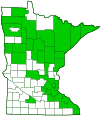dusky stink bug
(Euschistus tristigmus)
Conservation • Description • Habitat • Ecology • Distribution • Taxonomy
|
|
|||||||||||||
Description |
Dusky stink bug is a small, broad, dark brown to gray stink bug. It occurs in the northern United States above the 41st parallel and east of the Great Plains, and across southern Canada from coast to coast. It is common in Minnesota. It can be found in grasslands and hayfields but is more common in wooded areas. There are two subspecies of Euschistus tristigmus. Only the northern subspecies, E, t. luridus, is found in Minnesota. The southeastern subspecies, E, t. tristigmus, is smaller and has acute to spine-like humeral angles. Adults are ⅜″ to ½″ long and ¼″ to 5 ⁄16″ wide, smaller than other stink bugs in its genus. The head is small and narrow, much narrower than the thorax. It is tucked into a concave groove in the margin of the pronotum. There is no visible “neck” when viewed from above. There are two large, bulging, compound eyes and two small simple eyes (ocelli). There is no crosswise (transverse) groove between the compound eyes. The mouth parts are optimized for piercing and sucking, and take the form of a thick, curved, 3-segmented beak (rostrum). The rostrum is longer than the head and fits into a groove on the underside (sternum) when not in use. The antennae are exposed, conspicuous, slender, and long, much longer than the head but not as long as the body. They have five segments. The first segment is thicker than the second. The fifth segment and the last (apical) half of the fourth segment are dark brown to black. The remainder is orangish or reddish. The body is shield-shaped and elongated but no more than twice as long as wide. The upperside is gray, hairless, and densely covered with dark brown punctures. The angles in the shoulder (humeral) area on each side are rounded and have no projecting tooth. The lateral margins toward the front are scalloped to toothed. There are two pairs of wings, and they are held flat over the body when at rest. Between and at the wing bases there is a triangular plate (scutellum). The forewings (hemelytra) on the mature adult are as long as the abdomen but do not completely cover the sides of the abdomen. The sides of the abdomen are exposed and appear conspicuously striped when the wings are closed. The hemelytra have a thickened section at the base and a thin membranous section at the tip with a clear dividing line between the two. The thickened basal part is comprised of a narrow area (clavus) behind the scutellum when the wings are closed, and the remaining broad marginal area (corium). The scutellum is triangular and large, covering about half of the abdomen, but is not longer than the corium, and not reaching the tip of the abdomen. The tip of the scutellum is white or yellow and is mostly free of punctures. There is a dark spot, more a smudge, in the middle of the scutellum, and a similar but smaller spot in the middle of each corium. The spots are diffuse and may be barely visible. The hindwings are thin, membranous, and concealed under the forewings. The underside of the body is pale, contrasting sharply with the dark upper side. There are one to four black spots on the underside in the middle (medial) of the abdomen. The legs are pale. The fourth segment of the hind leg (tibia) is grooved above. It does not have spines. The end part of the leg, corresponding to the foot, (tarsus) has 3 segments. |
Size |
Total length: ⅜″ to ½″ |
Similar Species |
Habitat |
Woodlands |
Ecology |
Season |
Late May to early October |
Behavior |
|
Life Cycle |
Adults overwinter in leaf and plant litter. In the spring, the female lays clusters of barrel-shaped eggs in tight rows on the underside of leaves. |
Nymph Food |
Plant juices |
Adult Food |
Plant juices |
Distribution |
||
|
Sources |
|
| 11/18/2024 | ||
Occurrence |
||
Common |
||
Taxonomy |
|
Order |
Hemiptera (true bugs, hoppers, aphids, and allies) |
Suborder |
Heteroptera (true bugs) |
Infraorder |
Pentatomomorpha |
Superfamily |
Pentatomoidea (stink bugs, shield bugs, and allies) |
Family |
|
Subfamily |
Pentatominae |
Tribe |
Carpocorini |
Genus |
Euschistus (brown stink bugs) |
Subgenus |
Euschistus |
Subordinate Taxa |
|
dusky stink bug (Euschistus tristigmus luridus) dusky stink bug (Euschistus tristigmus tristigmus) |
|
Synonyms |
|
Pentatoma tristigma |
|
Common Names |
|
dusky stink bug |
|
Glossary
Corium
The thickened basal portion of the front wing that lies between the clavus and the membrane of insects in the family Hemiptera. Plural: coria.
Hemelytron
The forewing of true bugs (order Hemiptera), thickened at the base and membranous at the tip. Plural: hemelytra.
Ocellus
Simple eye; an eye with a single lens. Plural: ocelli.
Pronotum
The exoskeletal plate on the upper side of the first segment of the thorax of an insect.
Rostrum
The stiff, beak-like projection of the carapace or prolongation of the head of an insect, crustacean, or cetacean.
Scutellum
The exoskeletal plate covering the rearward (posterior) part of the middle segment of the thorax in some insects. In Coleoptera, Hemiptera, and Homoptera, the dorsal, often triangular plate behind the pronotum and between the bases of the front wings. In Diptera, the exoskeletal plate between the abdomen and the thorax.
Tarsus
On insects, the last two to five subdivisions of the leg, attached to the tibia; the foot. On spiders, the last segment of the leg. Plural: tarsi.
Tibia
The fourth segment of an insect leg, after the femur and before the tarsus (foot). The fifth segment of a spider leg or palp. Plural: tibiae.
Visitor Photos |
||
Share your photo of this insect. |
||
This button not working for you? |
||
Alfredo Colon |
||
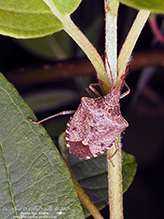 |
||
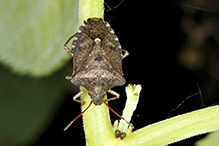 |
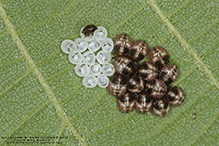 |
|
MinnesotaSeasons.com Photos |
||
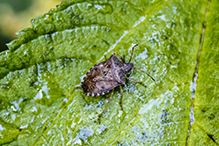 |
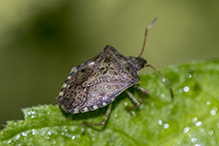 |
|
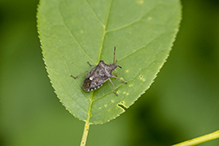 |
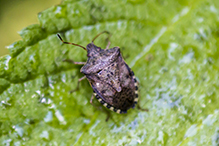 |

Slideshows |
|

Visitor Videos |
||
Share your video of this insect. |
||
This button not working for you? |
||
|
Other Videos |
||
DUSKY STINK BUG YTPAGANCHALLENGE 363 DAY 1.051 FALL - LOG - MAS |
About
Published on Sep 17, 2017 DUSKY STINK BUG |

Visitor Sightings |
||
Report a sighting of this insect. |
||
This button not working for you? |
||
Alfredo Colon |
Location: Albany, NY |
 |
| Alfredo Colon 8/2/2019 |
Location: Woodbury, Minnesota |
 |
| Alfredo Colon 6/10/2018 |
Location: Woodbury, Minnesota |
 |
MinnesotaSeasons.com Sightings |
||

Created: 3/18/2019 Last Updated: © MinnesotaSeasons.com. All rights reserved. |
